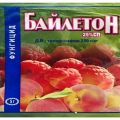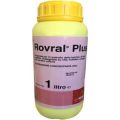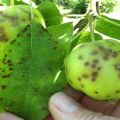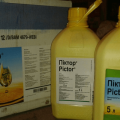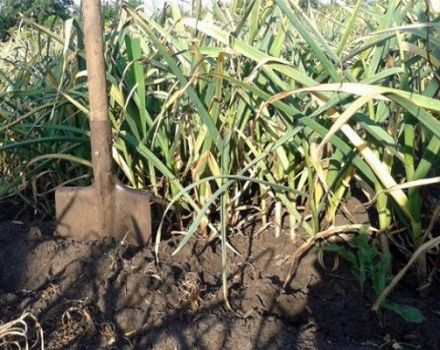Instructions for the use of the fungicide Tsikhom, consumption rates and analogues
Tsikhom is a plant treatment agent belonging to the class of contact fungicides. The tool is very popular among summer residents due to its versatility and effectiveness. It is used to treat most fruit and berry crops against fungal and bacterial infections. Consider the instructions for using the fungicide Tsikhom and figure out in which cases the drug will be effective and how to use it correctly.
Content
- 1 Composition, release form and purpose of the fungicide Tsikhom
- 2 How does a fungicide work?
- 3 Advantages and disadvantages of the drug
- 4 Consumption rate of funds
- 5 How to prepare a working solution
- 6 Instructions for using the solution
- 7 Precautions when working with the product
- 8 Drug toxicity
- 9 Compatibility with other drugs
- 10 How to store it correctly
- 11 Analogs
Composition, release form and purpose of the fungicide Tsikhom
Fungicide is intended for the prevention of most plant diseases caused by pathogenic bacteria and fungal spores. The active ingredients of Tsikhom are copper oxychloride and zineb. Copper oxychloride has the function of interrupting the germination of fungi. Tsineb, in turn, disrupts the metabolism in the cells of the pathogenic microorganism. The drug is supplied in boxes weighing one kilogram, as well as in ten-kilogram bags.
How does a fungicide work?
When interacting with a harmful microorganism, copper oxychloride interrupts the germination of its cells, blocking their respiration. The growth of cells is stopped due to the fact that the substance poisons moisture, which is vital for bacteria. Cineb interrupts the metabolism of ketak acids.
Advantages and disadvantages of the drug
The main advantage of a fungicide is the speed of its action on harmful microorganisms. Active substances begin to destroy fungal cells immediately after plant treatment. In addition, the product is safe for plants and can stimulate the process of photosynthesis. At the same time, the tool is sold at affordable prices.

Consumption rate of funds
The consumption rate of the drug depends on the treated culture and the diseases against which the treatment is applied. For example, for the treatment of an apple or pear against a scab, the consumption rate will be six to eight kilograms per hectare. For potatoes, the norm will be two and a half kilograms per hectare of land.
For fruit and berry plants such as raspberries, currants, the consumption will be from three to four kilograms.
How to prepare a working solution
In the process of preparing the solution, it is recommended to use soft filtered water. It shouldn't be too cold or hot. Use liquid at room temperature. The solution is prepared immediately before use, not earlier than two hours before the treatment itself.
Calculate the exact amount of the product, since the leftovers cannot be used next time - after a few hours the solution will begin to lose its properties.

Instructions for using the solution
Plants are treated with a ready-made fungicide solution by spraying ground shoots and leaves with sprayers. Spraying is performed several times per season, with an interval of two to four weeks. In addition, you can pickle seeds and tubers of plants with a solution before planting in the soil. Also, fungicides are applied directly to the soil during digging, thereby destroying harmful microorganisms living in the soil.
Precautions when working with the product
Be sure to use special protective clothing, masks and rubber gloves during handling. Do not leave exposed skin to prevent breakouts. If the solution gets on your skin, rinse thoroughly with clean water. If the drug has entered the esophagus, immediately perform a gastric lavage.

Drug toxicity
The drug Tsikhom is characterized by moderate toxicity to humans. May cause irritation on contact with exposed skin and mucous membranes. May provoke allergic redness. In the first hours after treatment, gas concentrations that are dangerous to humans accumulate in the air in the area, therefore, the treatment should be carried out in a protective suit and with a respirator.
The drug is toxic to bees, therefore, if it is necessary to use it near apiaries, bees should be isolated during processing.
Compatibility with other drugs
Tsikhom has a high degree of compatibility with most drugs. It can be used with virtually any organophosphorus compound. To test compatibility with a specific substance, prepare a small amount of solution by mixing the substances. If a precipitate does not form, you can use the funds together.
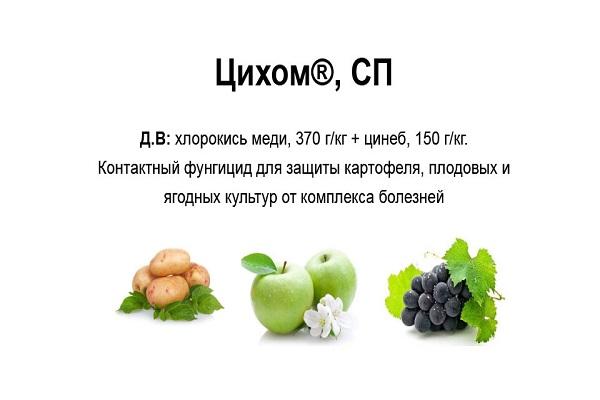
How to store it correctly
The shelf life of the drug in a sealed package is three years from the date of manufacture. Keep out of the reach of children. The prepared solution should be used immediately after its preparation.
Analogs
Preparations have a similar effect on fungal spores, as well as Tsikhom, belonging to the class of contact fungicides. This class of agents is not intended for the treatment of already infected plants, but demonstrates great effectiveness in the prevention of infection.


